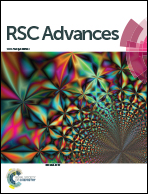Optimizing the interaction between poly(vinyl alcohol) and sandy soil for enhanced water retention performance†
Abstract
Poly(vinyl alcohol) (PVA) was used as a low-cost and degradable water retention agent in combating drought and desertification. The effect of PVA with different degrees of hydrolysis on the enhancement of water retention capacity of sandy soil and the growth performance of Arabidopsis thaliana were investigated. The results showed that PVA could effectively enhance the water retention capacity of sandy soil and the growth of plants in it. After the addition of PVA, the survival rate, aerial biomass and chlorophyll content of Arabidopsis thaliana all increased substantially compared to those in untreated soil under the condition of water shortage. The relationship between PVA's degree of hydrolysis and its water retention performance in sandy soil was also studied. It was found that PVA with a middle degree of hydrolysis, 1795 and 1797, had the best performance, which even catches up with the traditional cross-linked hydrogel-PAM, suggesting that PVA could be an effective water retention agent for improving plant growth in sandy soil and combating desertification. Through this study, a few criteria were proposed for the selection of better water retention agents, considering their water absorbency, retaining ability in sandy soil and degradability.


 Please wait while we load your content...
Please wait while we load your content...